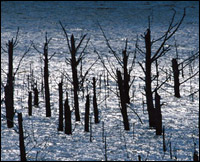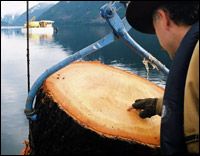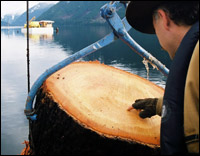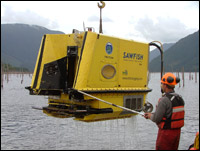As the traditional logging industry deals with unsteady prices and the challenges of globalization, the value of a new crop is coming to light: trees hidden under reservoirs, long given up for lost.
While no exact count of these “rediscovered” forests — which are being logged primarily in North and South America, Russia, and Malaysia — seems to exist, one estimate puts it at about 200 million trees, a global supply worth about $40 billion. These watery woods have been preserved by cold water and protected from rot and insect infestation. The resulting high-quality timber is highly sought after, especially by craftspeople.
Barges and divers have long gone after both standing trees and abandoned, sunken logs, but now a new technology is upping the ante, allowing more submerged trees to be cut more quickly. Proponents — including those developing the new high-tech method — say underwater harvests could help the planet, since they “spare” healthy forests in favor of the dead. Others contend the waterlogged trees are a nonrenewable resource whose harvest will simply detract attention from issues on land. In British Columbia this summer, a logging company and a First Nation band are embarking on a partnership that highlights the complicated allure of this new-old industry.
Supply and the Man
Interest in logging reservoirs is particularly keen in Canada, since the country has had difficulty competing with cheaper labor rates in places such as Brazil, Chile, Russia, and even the southern United States, says Rob Kozak, associate professor of forestry at the University of British Columbia. “This makes the market for commodity lumber less appealing,” he says. “The direction British Columbia needs to go [is] out of the lower-value products and more toward high-quality ones.”

The ghosts of Nechako.
Photo: Environmental Health Perspectives.
Much of British Columbia’s submerged timber — a bevy of pine, spruce, fir, cedar, and hemlock worth an estimated $2 billion — stands in three vast human-made lakes. At Nechako Reservoir, in the province’s interior, members of the Cheslatta Carrier Nation have spent the last few years reclaiming what they could from land that was seized and flooded in the 1950s. That’s when Alcan Inc., the world’s second-largest producer of primary aluminum behind Alcoa Inc., built a hydroelectric dam to provide electricity for an aluminum smelter.
For the 120 Cheslatta members still living nearby, the recoverable trees in the reservoir’s depths represent a source of revenue. “Ever since it was flooded, people have wanted to harvest this wood,” says Mike Robertson, economic development officer and senior policy adviser for the Cheslatta. “All of the locals know it’s a good log when it gets on land.” In 1996, B.C.’s Ministry of Forests granted the Cheslatta a 10-year license allowing them access to more than 3 million cubic meters of underwater lumber, and a second license issued subsequently permits them to log another 3 million.
Before granting such licenses, ministry auditors check factors like disturbance to the lake bed, employment of local workers, and, as in this case, First Nations’ rights to the wood. While land-based logging in the province is divided into “timber supply areas” — boundaries that let the government regulate the annual harvest — no such restrictions have been placed on the budding underwater industry. “It’s extra fiber that’s not part of the [timber supply area] annual allotment,” says John Gerow, a field office supervisor for the ministry. (A nice side benefit at Nechako, from the ministry’s perspective: clearing helps keep the reservoir competitive as a tourist destination. “There’ve always been obstacles in the waterways for boating,” says Mark Vieweg, district manager for B.C.’s Nadina Forest District. “Just from the perspective of cleaning up the reservoir, it [is] a bonus.”)
Since receiving their first license, the Cheslatta have worked with a B.C. salvage company to perform this hard, slow work with barges. They have also run a sawmill in partnership with local investors since 2001. But now they’re joining forces with Vancouver Island-based Triton Logging Company, using a new machine that might just make the harvest easier.
Paul Bunyan, Meet Jacques Cousteau
Deep under water, far from any surface light, a yellow, remote-controlled submarine grapples a pine. The tree is bare, its needles washed away decades ago. Once in a rare while, a fish wanders over, attracted to the lights. But any curious creature quickly swims away when the submarine’s pilot, stationed on a barge at the lake’s surface, fires up the chainsaw.
This is the Sawfish, hard at work. The machine, a boxy, nearly four-ton craft with five-foot arms and a 55-inch saw, was introduced by Triton Logging Company two years ago. While remotely operated submersibles aren’t a new concept — they’re used by oil-exploration companies, for one — the Sawfish appears to be the first one in the world armed with a saw and a taste for timber.
Under the pilot’s watchful eye, the Sawfish attaches an airbag capable of lifting up to 450 pounds to the nearly severed trunk. That’s when the action shifts from an image on a black-and-white monitor to the water’s surface. Depending upon the size of the tree, it will spring from the depths like a rocket thrust into orbit or elevate slowly, like a leviathan waking from a long sleep.
Traditionally, standing trees have been removed by unceremoniously pulling them out by their roots, a process that disrupts the lake bed and may even, some fear, release toxins from the soil. Triton president Chris Godsall, interested in tapping an unclaimed market, led the Sawfish design project in order to automate the harvest while leaving root systems intact. “Mostly it was foolishness that made me think we could do it,” he says.
The result of his foolishness is a machine that’s garnered scattered attention, including a segment on a Martha Stewart TV show last year. The Audubon Society praised Triton’s approach as “a great improvement over more dangerous and dirtier methods.” The Sawfish can cut a tree every three minutes and harvest about 100 trees per day. Since its maiden voyage, it has removed about 3,000 trees, most of them Douglas fir, western red cedar, and hemlock, from a small 1940s-era reservoir called Lois Lake.
The company has sold most of those logs to outfits ranging from small manufacturers like Woodland Flooring and Millwork in Comox, B.C., to larger entities in Boston and California, and even clients in Japan. As it embarks on the work at Nechako, Triton employees are also busy testing a second Sawfish at Lois Lake.
Ecosystem of a Down
Thus far, there’s been no word of protests against underwater logging lodged with the province or with those doing the work. Advocates of responsible logging seem to see the underwater version as a way to tap into a source of timber without the harmful side effects — such as road-building — that accompany land-based operations. Some also point out that very little life thrives in the deep, cold water of the province’s lakes.

Prey for the strength.
Photo: Indiana Department of Natural
Resources.
Plenty of life thrives at the surface of Nechako, though, in the form of 350 breeding pairs of resident osprey. “When the reservoir was created, there were no ospreys,” Gerow says. But the birds have made this place home, constructing massive nests in the crowns of the trees protruding from the reservoir’s shallower areas. The ministry, with the help of the loggers and Alcan, is protecting the osprey’s claim to the region by building new nests, which can weigh several hundred pounds, to replace those that break through the exposed, rotting tree crowns. By the end of the year, they’ll have built more than 80, Gerow says.
And although the ministry does not place restrictions on how underwater trees are harvested, it does monitor water quality and equipment. Loggers are not permitted to use petroleum-based oil for any equipment other than boat motors (the Sawfish, which is electric, uses vegetable oil in place of hydraulic fluid). At Nechako, Gerow says, research indicates there has been no harm to water quality or fish habitat.
UBC’s Kozak says the greatest potential downside to underwater logging is facing customers’ concerns about how the wood is harvested. As in traditional logging, such worries can be assuaged by certification. Triton has achieved a SmartWood “Rediscovered Wood” stamp of approval from The Rainforest Alliance. (The Forest Stewardship Council, the most well-known timber-certification organization, hasn’t set standards for underwater salvage operations.) “It’s not about competitive advantage; you need to be certified,” Kozak says, pointing out that large retailers including The Home Depot and Ikea are increasingly buying sustainably harvested wood.
The SmartWood certification has also opened the door for Triton to sell its lumber to TerraMai, a McCloud, Calif., company that specializes in buying, cleaning, and reselling wood from old railroads, demolished houses, and now underwater forests. SmartWood means Triton’s operation is “environmentally benign,” says TerraMai cofounder Richard McFarland. “They are legitimately salvaging wood, which makes it easier for us to sell.” TerraMai has thus far purchased more than 30,000 board feet from Triton, and “we’re just getting started with them,” McFarland says.
“My customers are by and large leaning toward environmentally favorable products,” McFarland reports, noting that he would be willing to buy lumber from other companies that retrieve submerged wood, but wouldn’t consider a long-term relationship unless they’ve earned some sort of certification.
“I’m all for salvaging wood that would go to waste otherwise,” he says, “but if you do it at the expense of underwater habitat, it defeats the purpose.”




